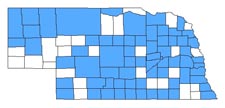
| Cicidela repanda repanda Dejean |
| Adult Length: 10.5 to 13.5 mm |
| Appearance: Adults are brownish bronze in color with a generous amount of maculation. The marginal band may or may not be narrowly connected to the humeral lunule, but always terminates well short of the apical lunule. |
| Similar Species: This species can easily be confused with C. hirticollis. Cicindela repanda appears very similar, but the posthumeral section of the humeral lunule extends laterally to slightly forward and is normally re-curved at the end in C. hirticollis. In C. repanda this mark is not re-curved at the end and normally extends at a slight angle toward the posterior. The middle band and humeral lunule are broadly connected in C. hirticollis, while in C. repanda the two are either not connected or only very narrowly. It could also be confused with C. duodecimguttata. It differs from C. duodecimguttata in that the color is brownish bronze rather than dark brown to almost blackish, and that the marginal band in C. repanda nearly touches the humeral lunule. If present, it stops well short of the humeral lunule in C. duodecimguttata. The middle band in C. duodecimguttata is most often fragmented while in C. repanda it is continuous. |
| Biology: This species prefers moist sandy soils but will tolerate some clay or silt. It can often be seen by the hundreds on river sandbars and lake beaches. Abandoned sand and gravel pits often support very large populations in moist areas. Even swimming beaches may have large populations. It is a skittish species, but most often only flies about 5 to 10 meters when alarmed. It is normally an abundant insect wherever there are open sandy soils that are constantly moist. |
| Adult Life History: Adults emerge in August and September before overwintering. Activity resumes in March and April and adults remain common well into the summer. Numbers drop gradually after June and adults are usually scarce by late July. It is a spring-fall species |
| Larval Life History: Larvae occur in vertical burrows in moist soils, most often on beaches and sandbars. They are usually distributed somewhat farther up the beach than those of C. hirticollis. They may also occur on steep riverbanks. Though Shelford (1908) reports a two-year life cycle in Illinois ( Chicago area), it is likely that a few larvae might mature in a single season in most of Nebraska. Most; however, probably require two years as evidenced by an abundance of third instars in May and June. Eggs are laid mostly from April to June and it is believed that most larvae pupate by mid-July of the following summer and emerge as adults in August and September. |
| Biogeography: This species is abundant throughout most of Nebraska. It probably occurs in nearly every county. Surprisingly, surveys in Johnson, Pawnee, Kimball, Banner, Cheyenne, and Deuel Counties failed to yield this abundant species. It likely occurs in Deuel County along the South Platte River. In North America it occurs across most of the United States, but is spotty west of the Rocky Mountains, and is lacking from the West Coast. It also ranges well into Canada. Three subspecies have been described. |




